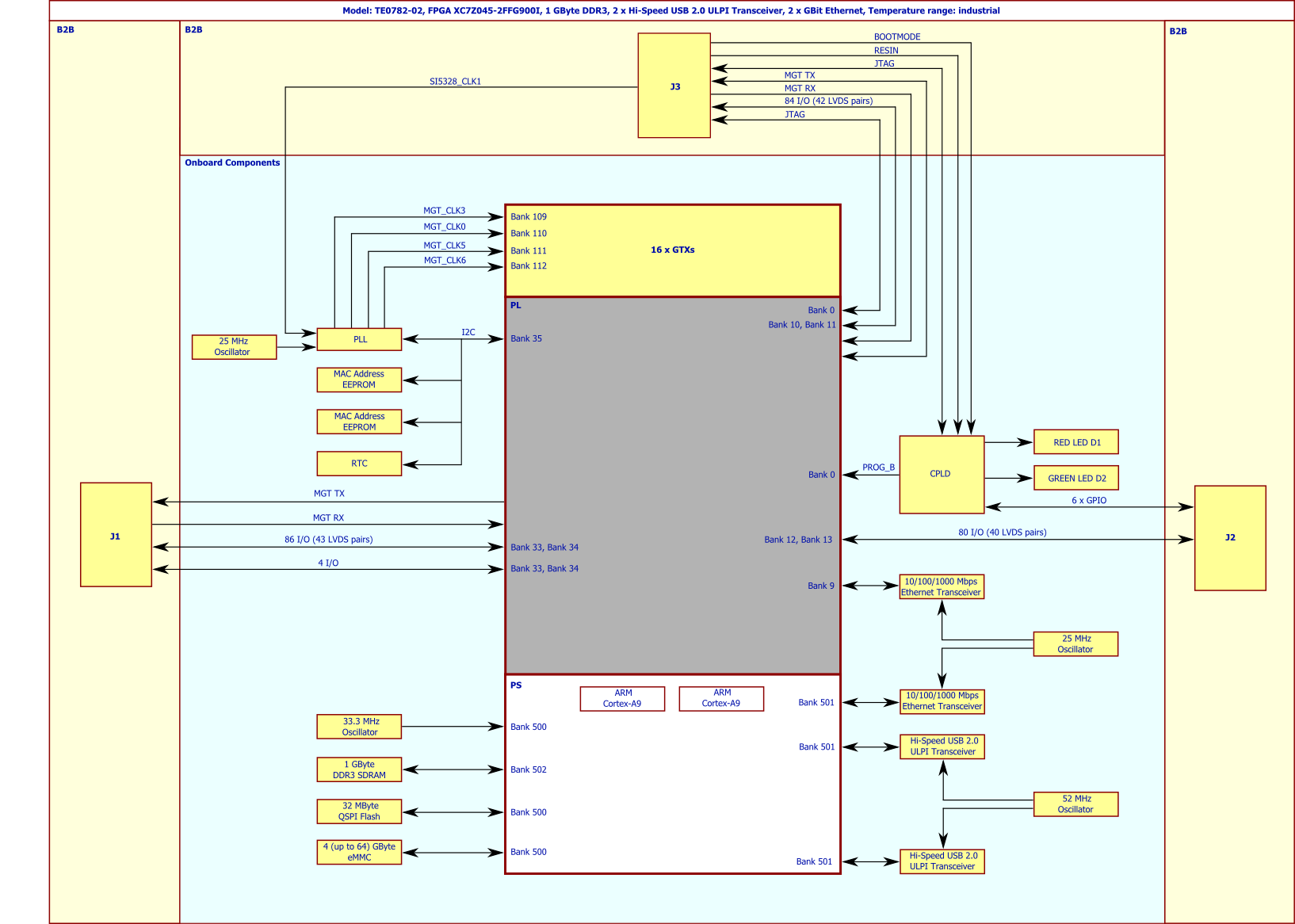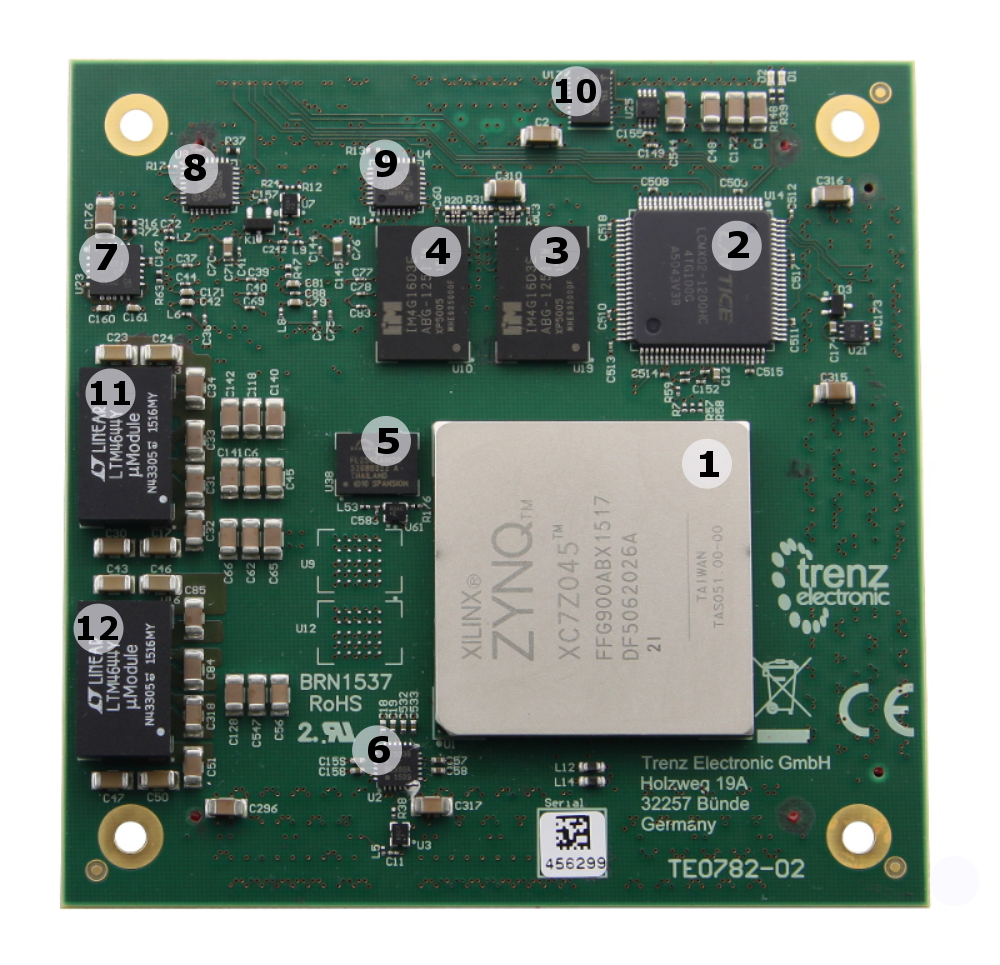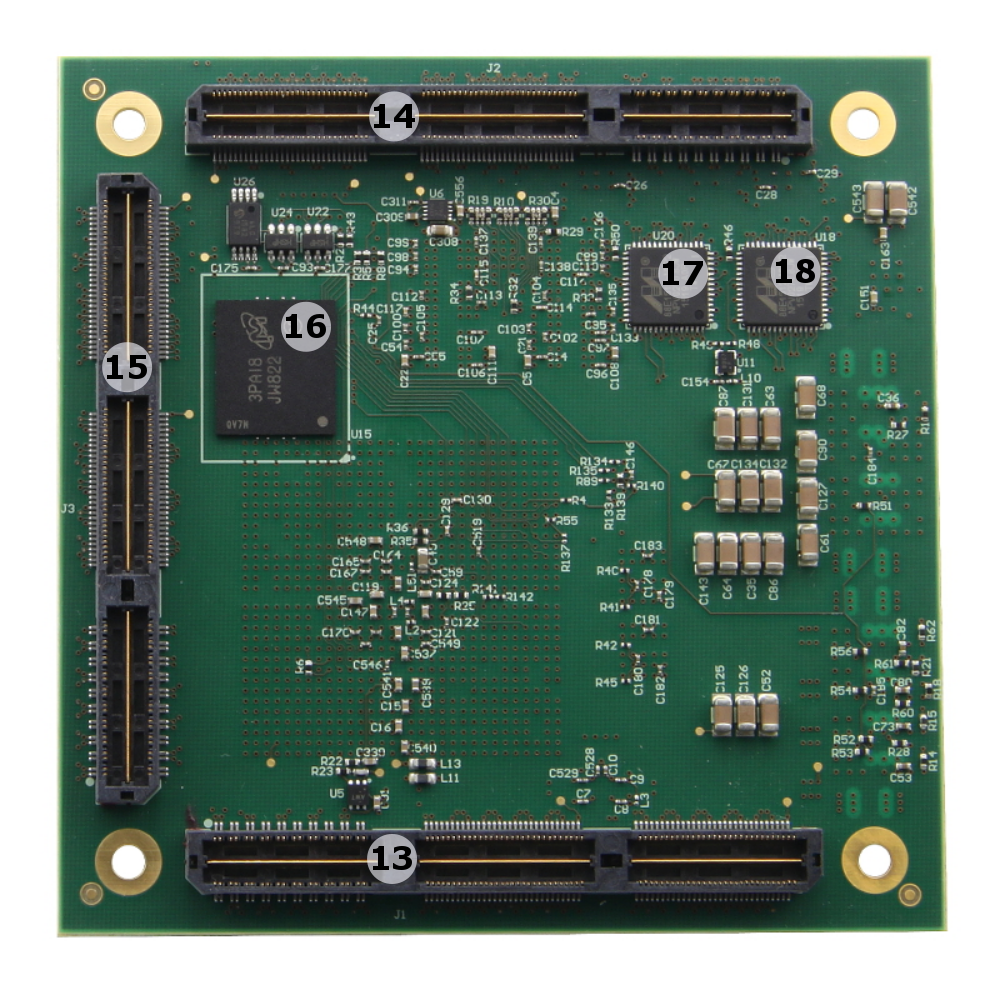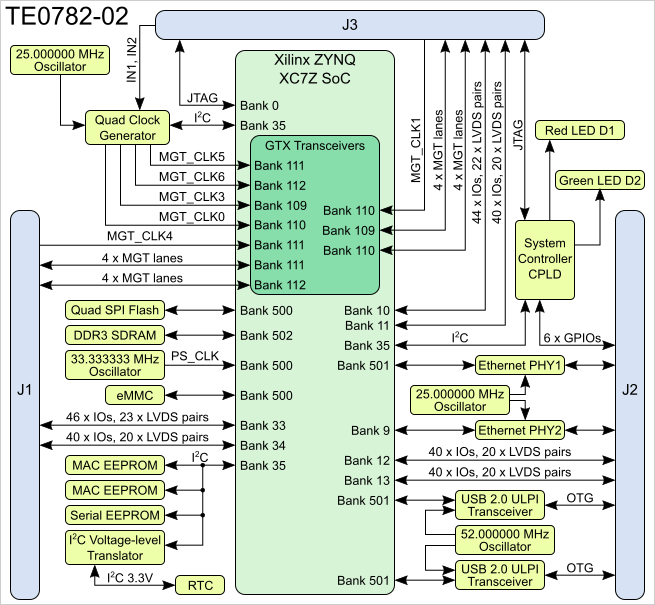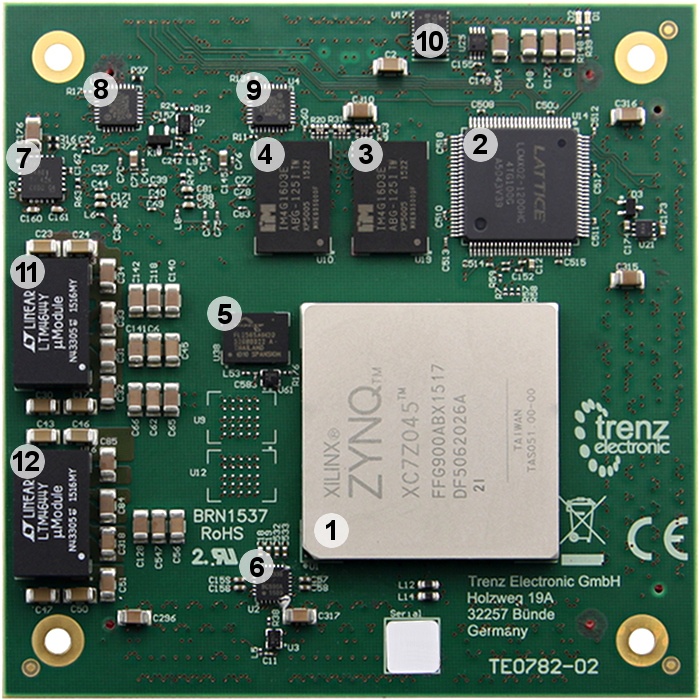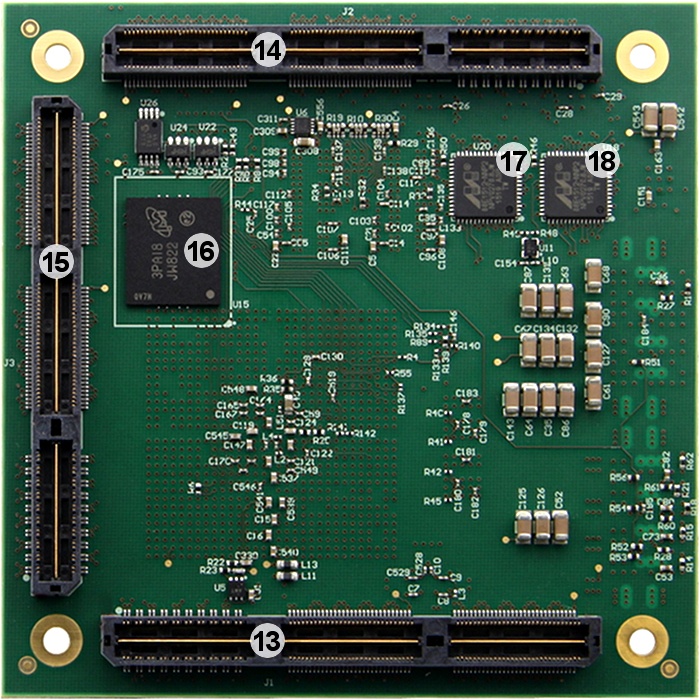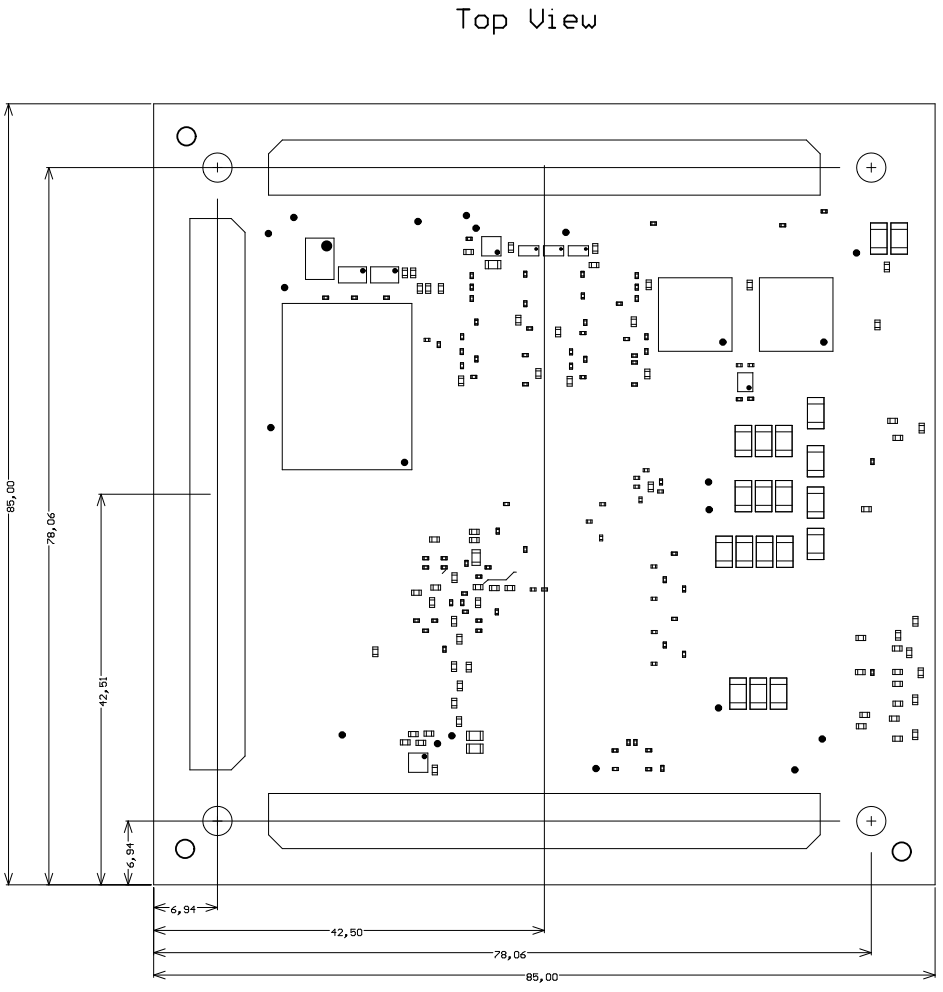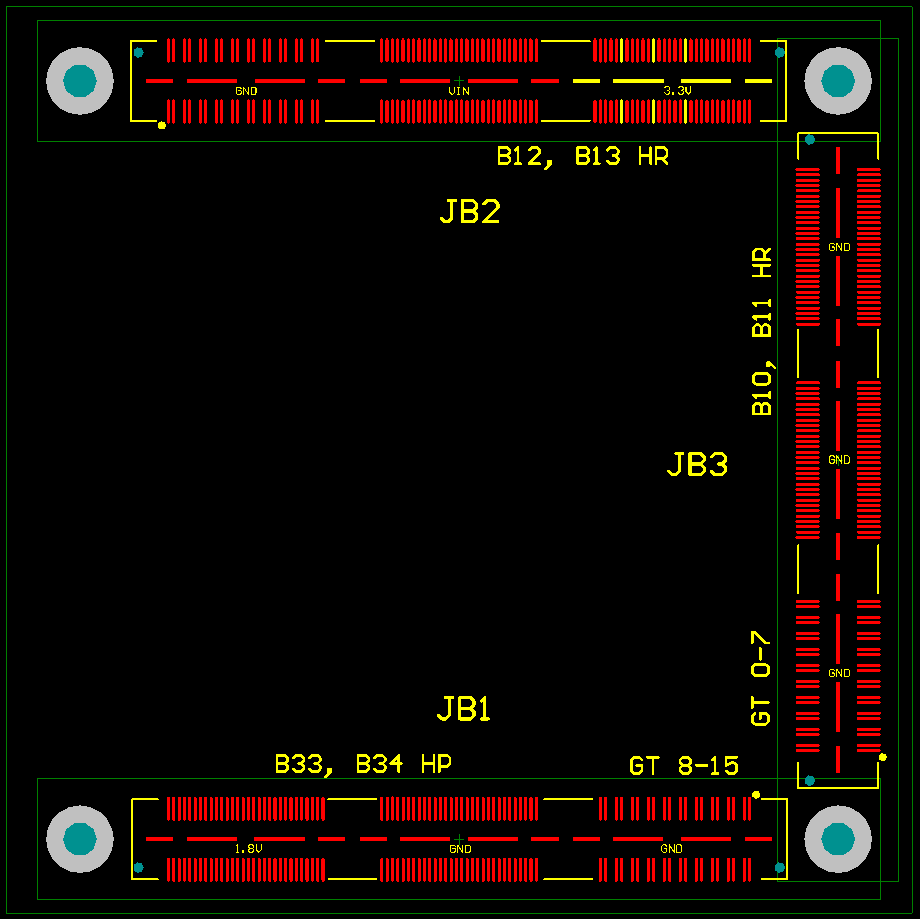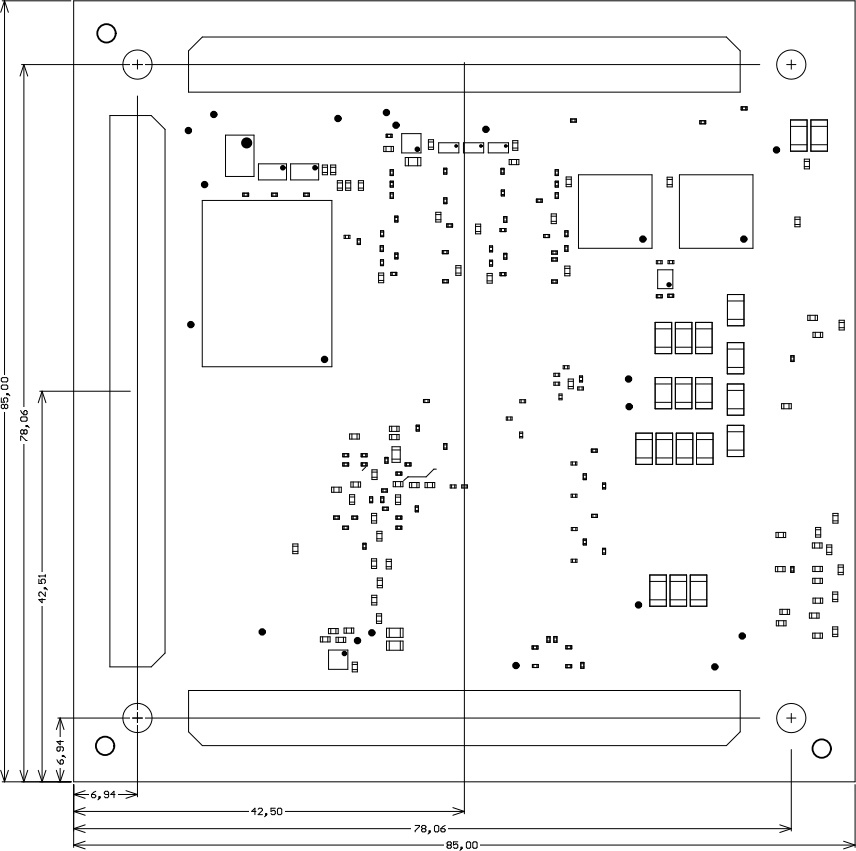Page History
...
Overview
| Scroll Only (inline) |
|---|
OnRefer to https://wiki.trenz-electronic.de/display/PD/TE0782-02+TRM thefor online version of this manual and otherthe documentsrest canof beavailable founddocumentation. |
The Trenz Electronic TE0782 is a high-performance, industrial-grade SoM (System on Module) with industrial temperature range based on Xilinx Zynq-7000 SoC . It is equipped with a Xilinx Zynq-7 (XC7Z035, XC7Z045 or XC7Z100).
...
All parts cover at least industrial temperature range of -40°C to +85°C. The module operating temperature range depends on customer design and cooling solution. Please contact us for options and for modified PCB-equipping due increasing cost-performance-ratio and prices for large-scale order.
Block Diagram
Main Components
| Page break |
|---|
The SoM TE0782-02 has following components on board:
Key Features
- Xilinx Zynq-7 XC7Z035, XC7Z045 or XC7Z100 SoC
...
Intersil ISL12020MIRZ Real-Time-Clock
...
LT Quad 4A PowerSoC DC-DC Converter @3.3V, @1,8V, @1.2V_MGT, @1.0V_MGT
...
Micron Technology 4 GByte eMMC
...
| Page break |
|---|
- Rugged for shock and high vibration
- Large number of configurable I/Os are provided via rugged high-speed stacking strips
- Dual ARM Cortex-A9 MPCore
- 1 GByte RAM (32-Bit wide DDR3)
- 32 MByte QSPI Flash memory
- 2 x Hi-Speed USB2.0 ULPI transceiver PHY
- 2 x Gigabit (10/100/1000 Mbps) Ethernet transceiver PHY
- 4 GByte eMMC (optional up to 64 GByte)
- 2 x MAC-address EEPROMs
- Optional 2 x 8 MByte HyperRAM (max 2 x 32 MByte) or optional 2 x 64 MByte HyperFLASH
- Temperature compensated RTC (real-time clock)
- Si5338 PLL for GTX transceiver clocks
- Plug-on module with 3 x 160-pin high-speed strips
- 16 GTX high-performance transceiver
- GT transceiver clock inputs
- 254 FPGA I/O's (125 LVDS pairs)
- On-board high-efficiency switch-mode DC-DC converters
- System management
- eFUSE bit-stream encryption
- AES bit-stream encryption
- Evenly-spread supply pins for good signal integrity
- User LED
Assembly options for cost or performance optimization available upon request.
Block Diagram
Main Components
- Xilinx Zynq XC7Z SoC (XCZ035, XC7Z045 or XC7Z100), U1
- Lattice Semiconductor MachXO2 1200HC System Controller CPLD, U14
- Intelligent Memory 4Gbit DDR3L-1600 SDRAM, U19
- Intelligent Memory 4Gbit DDR3L-1600 SDRAM, U10
- Spansion 32 MByte QSPI Flash memory, U38
- SI5338A PLL programmable clock generator, U2
- TI low-dropout linear regulator @1.5V, U23
- Microchip USB3320C USB PHY transceiver, U8
- Microchip USB3320C USB PHY transceiver, U4
Intersil ISL12020MIRZ Real Time Clock, U17
- LT quad 4A PowerSoC DC-DC converter (1.0V), U13
LT quad 4A PowerSoC DC-DC converter (3.3V, 1,8V, 1.2V_MGT, 1.0V_MGT), U16
- Samtec ASP-122952-01 160-pin stacking strip (2 rows a 80 positions), J1
- Samtec ASP-122952-01 160-pin stacking strip (2 rows a 80 positions), J2
- Samtec ASP-122952-01 160-pin stacking strip (2 rows a 80 positions), J3
Micron Technology 4 GByte eMMC, U15
- Marvell Alaska 88E1512 Gigabit Ethernet PHY, 20
- Marvell Alaska 88E1512 Gigabit Ethernet PHY, U18
Initial Delivery state
| Storage device name | Content | Notes |
|---|---|---|
| 24LC128-I/ST | not programmed | User content |
24AA025E48 EEPROM's | User content not programmed | Valid MAC Address from manufacturer |
| eMMC Flash-Memory | Empty, not programmed | Except serial number programmed by flash vendor |
SPI Flash OTP Area | Empty, not programmed | Except serial number programmed by flash vendor |
SPI Flash Quad Enable bit | Programmed | |
SPI Flash main array | demo design | |
| HyperFlash RAM | not programmed | |
eFUSE USER | Not programmed |
|
eFUSE Security | Not programmed |
Signals, Interfaces and Pins
Board to Board (B2B) I/Os
I/O signals connected to the SoC's I/O banks and B2B connector:
| Bank | Type | VCCIO Max | Connector | IO count | Differential | IO Voltage | Notes |
|---|---|---|---|---|---|---|---|
| 10 | HR | 3.3V | J3 | 44 | 22 | user | |
| 11 | HR | 3.3V | J3 | 40 | 20 | user | |
| 12 | HR | 3.3V | J2 | 40 | 20 | user | |
| 13 | HR | 3.3V | J2 | 40 | 20 | user | |
| 33 | HP | 1.8V | J1 | 48 | 23 | user | |
| 34 | HP | 1.8V | J1 | 42 | 20 | user |
For detailed information about the pin out, please refer to the Master pin-out table.
JTAG Interface
JTAG access to the Xilinx Zynq device is provided through B2B connector J3.
| Signal | B2B Pin |
|---|---|
| TCK | J3-141 |
| TDI | J3-147 |
| TMS | J3-142 |
| TDO | J3-148 |
JTAG access to the System Controller CPLD device is provided through B2B connector J3.
| Signal | B2B Pin |
|---|---|
| M_TCK | J3-81 |
| M_TDI | J3-87 |
| M_TMS | J3-82 |
| M_TDO | J3-88 |
| Note |
|---|
JTAGENB pin in J3 should be kept low or grounded for normal operation. |
System Controller CPLD I/O Pins
Special purpose pins to configure and operate the System Controller CPLD (IC U14):
| Name | Connection | Note |
|---|---|---|
| CLPD_GPIO7 | B2B | Function defined by CPLD Firmware (legacy name was BOOTMODE) |
| CLPD_GPIO6 | B2B | Function defined by CPLD Firmware (legacy name was CONFIGX) |
| JTAGENB | B2B | Logic high enables CPLD JTAG pins, when low CPLD JTAG access is disabled |
| nRST_IN | B2B | Active low System-reset input (old name RESIN) |
| CLPD_GPIO0 | B2B | Function defined by CPLD Firmware |
| CLPD_GPIO1 | B2B | Function defined by CPLD Firmware |
| CLPD_GPIO2 | B2B | Function defined by CPLD Firmware |
| CLPD_GPIO3 | B2B | Function defined by CPLD Firmware |
| CLPD_GPIO4 | B2B | Function defined by CPLD Firmware |
| CLPD_GPIO5 | B2B | Function defined by CPLD Firmware |
| CPLD_IO | PL |
Some of the functions of the SoM are controlled by the System Controller CPLD and it's firmware. User can change this by using(creating) different firmware for the System Controller CPLD.
On-board LEDs
| LED | Color | Connected to | Description |
|---|---|---|---|
| D1 | Red | LED2 | Function depends on System Controller CPLD firmware version. |
| D2 | Green | LED1 | Function depends on System Controller CPLD firmware version. |
| Page break |
|---|
Clocking
Silicon Labs PLL Si5338 is used to supply reference clock for MGT banks. Optionally MGT reference clocks can also be supplied from the baseboard for any of the MGT banks. Reference clock for the Si5338 quad clock generator itself can be supplied by the on-board oscillator (U3) or from the baseboard.
| Clock | Frequency | IC | Zynq PS / PL | Notes |
|---|---|---|---|---|
| PS CLK | 33.333333 MHz | U61 | PS CLK | PS subsystem main clock |
| ETH PHY reference | 25.000000 MHz | U11 | - | |
| USB PHY reference | 52.000000 MHz | U7 | - | |
PLL reference | 25.000000 MHz | U3 | - | |
GT REFCLK1 | - | B2B connector | Bank 110, pin AC7/AC8 | Supplied from baseboard. |
GT REFCLK4 | - | B2B connector | Bank 111, pin U7/U8 | Supplied from baseboard. |
| Si5338 CLK0 | U2 | Bank 110, pin AA8/AA7 | ||
| Si5338 CLK1 | U2 | Bank 109, pin AF10/AF9 | ||
| Si5338 CLK2 | U2 | Bank 111, pin W8/W7 | ||
| Si5338 CLK3 | U2 | Bank 112, pin N8/N7 |
Default MIO Mapping
| MIO | Configured as | B2B | Notes |
|---|---|---|---|
| 0 | USB Reset | - | CPLD used as level translator |
| 1 | QSPI0 | - | SPI Flash-CS |
| 2 | QSPI0 | - | SPI Flash-DQ0 |
| 3 | QSPI0 | - | SPI Flash-DQ1 |
| 4 | QSPI0 | - | SPI Flash-DQ2 |
| 5 | QSPI0 | - | SPI Flash-DQ3 |
| 6 | QSPI0 | - | SPI Flash-SCK |
| 7 | Ethernet Reset | - | CPLD used level translator |
| 8 | UART TX | JC3:129 | output, muxed |
Key Features
- Xilinx Zynq-7 XC7Z035, XC7Z045 or XC7Z100 SoC
- Rugged for shock and high vibration
- large number of configurable I/Os is provided via rugged high-speed stacking strips
- Dual ARM Cortex-A9 MPCore
- 1 GByte RAM (32-Bit wide DDR3)
- 32 MByte QSPI Flash memory
- 2 x Hi-Speed USB2.0 ULPI transceiver PHY
- 2 x Gigabit (10/100/1000 Mbps) Ethernet transceiver PHY
- 4 GByte eMMC (optional up to 64GByte)
- 2 x MAC-Address EEPROMs
- optional 2 x 8 MByte HyperRAM (max 2 x 32 MByte HyperRAM) or optional 2 x 64 MByte HyperFLASH
- Temperature compensated RTC (real-time clock)
- Si5338 PLL for GTX Transceiver clocks
- Plug-on module with 3 x 160-pin high-speed strips
- 16 GTX high-performance transceiver
- GT transceiver clock inputs
- 254 FPGA I/O's (125 LVDS pairs)
- On-board high-efficiency switch-mode DC-DC converters
- System management
- eFUSE bit-stream encryption
- AES bit-stream encryption
- Evenly-spread supply pins for good signal integrity
- User LED
Assembly options for cost or performance optimization available upon request.
Signals, Interfaces and Pins
System Controller CPLD I/O-Pins
Special purpose pins to configure and operate the System Controller CPLD (IC U14) used by TE0782:
...
Small CPLD controls some functions of the SoM, this CPLD can be updated by the end user if support is designed in on customer base.
Boot Modes
TE0782 supports primary boot from
- SPI Flash
Boot from on-board eMMC is also supported as secondary boot (FSBL must be loaded from SPI Flash).
JTAG Bootmode is always possible no matter the Zynq Boot mode selected.
| Page break |
|---|
JTAG
JTAG access to the Xilinx Zynq-7000 device is provided by connector J3.
| Signal | B2B Pin |
|---|---|
| TCK | J3: 141 |
| TDI | J3: 147 |
| TDO | J3: 148 |
| TMS | J3: 1142 |
CPLD-JTAG access to the Xilinx Zynq-7000 device is provided by connector J3.
...
| Note |
|---|
JTAGENB pin in J3 should be kept low or grounded for normal operation. |
Clocking
Silabs Multisynth PLL Si5338 can deliver GT reference clocks to all 4 GT Banks. Additionally a GT Reference clock can be generated on the base board for any of the 4 GT Banks. There is reference clock available on the TE0782 for Si5338, optionally external reference clock can be supplied from the base.
...
PLL reference
...
25 MHz
...
U3
...
-
...
GT REFCLK1
...
-
...
B2B connector
...
BANK110, Pin AC7/AC8
...
Externally supplied from base
...
GT REFCLK4
...
-
...
B2B connector
...
BANK111, Pin U7/U8
...
Externally supplied from base
...
Processing System (PS) Peripherals
...
optional 2 x 8 MByte HyperRAM (max 2 x 32 MByte HyperRAM)
or optional 2 x 64 MByte HyperFLASH
...
Default MIO mapping
| MIO | Configured as | B2B | Notes |
|---|---|---|---|
| 0 | USB Reset | - | CPLD used as level translator |
| 1 | QSPI0 | - | SPI Flash-CS |
| 2 | QSPI0 | - | SPI Flash-DQ0 |
| 3 | QSPI0 | - | SPI Flash-DQ1 |
| 4 | QSPI0 | - | SPI Flash-DQ2 |
| 5 | QSPI0 | - | SPI Flash-DQ3 |
| 6 | QSPI0 | - | SPI Flash-SCK |
| 7 | Ethernet Reset | - | CPLD used level translator |
| 8 | UART TX | JC3:129 | output, muxed to B2B by the SC CPLD |
| 9 | UART RX | JC3:135 | input, muxed to B2B by the SC CPLD |
| 10 | SDIO1 D0 | - | - |
| 11 | SDIO1 CMD | - | - |
| 12 | SDIO1 CLK | - | - |
| 13 | SDIO1 D1 | - | - |
| 14 | SDIO1 D2 | - | - |
| 15 | SDIO1 D3 | - | - |
| 16..27 | ETH0 | - | Ethernet RGMII PHY |
| 28..39 | USB0 | - | USB0 ULPI PHY |
| 40...51 | USB1 | - | USB1 ULPI PHY |
| 52 | ETH0 MDC | - | - |
| 53 | ETH0 MDIO | - | - |
Pin Definitions
Pins named _vrn and _vrp are connected to ZYNQ PL HP Bank special purpose pins VRN/VRP. If needed they can be connected to DCI calibration resistors on the base. If not, then those pins can be used as general purpose I/O.
Bank B35 has 100 ohm DCI calibration resistors installed on TE0782, it is also possible to "borrow" the DCI calibration from B35 for banks B34, and B33. For detailed usage of the DCI check Xilinx documentation.
I2C Interface
The on-board I2C components are connected to BANK35, Pin L15 (I2C_SDA) and to BANK35, Pin L14 (I2C_SCL).
I2C addresses for on-board components
...
B2B I/O
Number of I/O's connected to the SoC's I/O bank and B2B connector
| Bank | Type | VCCIO Max | Connector | IO count | Differentíal | IO Voltage | Notes |
|---|---|---|---|---|---|---|---|
| 10 | HR | 3.3V | J3 | 44 | 22 | user | |
| 11 | HR | 3.3V | J3 | 40 | 20 | user | |
| 12 | HR | 3.3V | J2 | 40 | 20 | user | |
| 13 | HR | 3.3V | J2 | 40 | 20 | user | |
| 33 | HP | 1.8V | J1 | 48 | 23 | user | |
| 34 | HP | 1.8V | J1 | 42 | 20 | user |
For detailed information about the pin out, please refer to the Master Pinout Table.
Peripherals
LEDs
D1 - Onboard RED LED
...
This function depend on the CPLD revision.
D2 - On-board GREEN LED
Green LED connected to MIO8
Ethernet
The TE0782 is equipped with two Marvell Alaska 88E1512 Gigabit Ethernet PHYs (U18 (ETH1) and U20 (ETH2)). The transceiver PHY of ETH1 is connected to the Zynq PS Ethernet GEM0. The I/O Voltage is fixed at 1.8V. The reference clock input for both PHYs is supplied from an on board 25MHz oscillator (U11).
ETH1 PHY connection:
...
Page break
ETH2 PHY connection:
...
-
...
USB
The TE0782 is equipped with two USB PHY's USB3320 from Microchip (U4 (USB0) and U8 (USB1)). The ULPI interface of USB0 is connected to the Zynq PS USB0, ULPI interface of USB1 to Zynq PS USB1. The I/O Voltage is fixed at 1.8V.
The reference clock input of both PHY's is supplied from an on board 52MHz oscillator (U7).
USB0 PHY connection:
...
Gigabit Ethernet
The TE0782 is equipped with two Marvell Alaska 88E1512 Gigabit Ethernet PHYs (U18 (ETH1) and U20 (ETH2)). The transceiver PHY of ETH1 is connected to the Zynq PS Ethernet GEM0. The I/O Voltage is fixed at 1.8V. The reference clock input for both PHYs is supplied from an on board 25MHz oscillator (U11).
ETH1 PHY connection:
| PHY PIN | ZYNQ PS / PL | System Controller CPLD | Notes |
|---|---|---|---|
| MDC/MDIO | MIO52, MIO53 | - | - |
| LED0 | BANK35, Pin B12 | - | - |
| LED1 | BANK35, Pin C12 | - | - |
| Interrupt | BANK35, Pin A15 | - | - |
| CONFIG | BANK35, Pin F14 | - | - |
| RESETn | - | Pin 53 | ETH1_RESET33 (MIO7) -> CPLD -> ETH1_RESET |
| RGMII | MIO16..MIO27 | - | |
| MDI | - | - | on B2B J2 connector |
Page break
ETH2 PHY connection:
| PHY PIN | Zynq PS / PL | System Controller CPLD | Notes |
|---|---|---|---|
| MDC/MDIO | BANK35, Pin C17/B17 | - | - |
| LED0 | BANK35, Pin K15 | - | - |
| LED1 | BANK35, Pin B16 | - | - |
| Interrupt | BANK35, Pin A17 | - | - |
| CONFIG | BANK35, Pin E15 | - | Pin connected to GND, PHY Address is strapped to 0x00 by default |
| RESETn | BANK35, Pin B15 | - | - |
| RGMII | BANK9 | - | - |
| MDI | - | - | - |
USB Interface
The TE0782 is equipped with two USB PHY's USB3320 from Microchip (U4 (USB0) and U8 (USB1)). The ULPI interface of USB0 is connected to the Zynq PS USB0, ULPI interface of USB1 to Zynq PS USB1. The I/O Voltage is fixed at 1.8V.
The reference clock input of both PHY's is supplied from an on board 52MHz oscillator (U7).
USB0 PHY connection:
| PHY Pin | Zynq PS / PL | CPLD | B2B Name (J2) | Notes |
|---|---|---|---|---|
| ULPI | MIO28..39 | - | - | Zynq USB0 MIO pins are connected to the PHY |
| REFCLK | - | - | - | 52MHz from on board oscillator (U7) |
| REFSEL[0..2] | - | - | - | 000 GND, select 52MHz reference Clock |
| RESETB | MIO0 | OTG_RESET33 | - | OTG_RESET33 -> CPLD -> OTG_RESET |
| CLKOUT | MIO36 | - | - | Connected to 1.8V selects reference clock operation mode |
| DP,DM | - | - | USB1_D_P, USB1_D_N | USB Data lines |
| CPEN | - | - | VBUS1_V_EN | External USB power switch active high enable signal |
| VBUS | - | - | USB1_VBUS | Connect to USB VBUS via a series resistor. Check reference schematic |
| ID | - | - | OTG1_ID | For an A-Device connect to ground, for a B-Device left floating |
Page break
USB1 PHY connection:
| PHY Pin | ZYNQ PS / PL | CPLD | B2B Name (J2) | Notes |
|---|---|---|---|---|
| ULPI | MIO40..51 | - | - | Zynq USB1 MIO pins are connected to the PHY |
| REFCLK | - | - | - | 52MHz from on board oscillator (U7) |
| REFSEL[0..2] | - | - | - | 000 GND, select 52MHz reference Clock |
| RESETB | MIO0 | OTG_RESET33 | - | OTG_RESET33 -> CPLD -> OTG_RESET |
| CLKOUT | MIO48 | - | - | Connected to 1.8V selects reference clock operation mode |
| DP,DM | - | - | USB2_D_P, USB2_D_N | USB Data lines |
| CPEN | - | - | VBUS2_V_EN | External USB power switch active high enable signal |
| VBUS | - | - | USB2_VBUS | Connect to USB VBUS via a series resistor. Check reference schematic |
| ID | - | - | OTG2_ID | For an A-Device connect to ground, for a B-Device left floating |
The schematic for the USB connector and required components is different depending on the USB usage. USB standard A or B connectors can be used for Host or Device modes. A Mini USB connector can be used for USB Device mode. A USB Micro connector can be used for Device mode, OTG Mode or Host Mode.
I2C Interface
The on-board I2C components are connected to bank 35 pins L15 (I2C_SDA) and L14 (I2C_SCL).
I2C addresses for on-board components:
| Device | IC | Designator | I2C-Address | Notes |
|---|---|---|---|---|
| EEPROM | 24LC128-I/ST | U26 | 0x53 | user data, parameter |
| EEPROM | 24AA025E48T-I/OT | U22 | 0x50 | MAC address EEPROM |
| EEPROM | 24AA025E48T-I/OT | U24 | 0x51 | MAC address EEPROM |
| RTC | ISL12020MIRZ | U17 | 0x6F | Temperature compensated real time clock |
| Battery backed RAM | ISL12020MIRZ | U17 | 0x57 | Integrated in RTC |
| PLL | SI5338A-B-GMR | U2 | 0x70 | |
| CPLD | LCMXO2-1200HC-4TG100I | U14 | user | - |
Pin Definitions
Pins with names ending with _VRN and _VRP are connected to Zynq PL HP bank special purpose pins VRN/VRP and can be routed to DCI calibration resistors on the baseboard. Otherwise they are useable as general purpose I/Os.
Bank 35 has 100 ohm DCI calibration resistors installed, it is also possible to "borrow" the DCI calibration from bank 35 for banks 34 and 33. For more detailed information about the DCI check Xilinx documentation.
On-board peripherals
Processing System (PS) Peripherals
| Peripheral | IC | Designator | Zynq PS / PL | MIO | Notes |
|---|---|---|---|---|---|
| QSPI Flash | S25FL256SAGBHI20 | U38 | PS QSPI0 | MIO1...MIO6 | - |
| ETH0 10/100/1000 Mbps PHY | 88E1512-A0-NNP2I000 | U18 | PS ETH0 | MIO16...MIO27, MIO52, MIO53 | - |
| ETH0 10/100/1000 Mbps PHY Reset | PS GPIO | MIO7 | ETH1_RESET33 (MIO7) -> CPLD -> ETH1_RESET | ||
| ETH1 10/100/1000 Mbps PHY | 88E1512-A0-NNP2I000 | U20 | BANK9, BANK35 | - | PHY can be used with soft Ethernet MAC IP also |
| ETH1 10/100/1000 Mbps PHY Reset | BANK35, Pin B15 | - | - | ||
| USB0 | USB3320C-EZK | U4 | PS USB0 | MIO28...MIO39 | - |
| USB0 Reset | PS GPIO | MIO0 | OTG_RESET33 (MIO0) -> CPLD -> OTG_RESET | ||
| USB1 | USB3320C-EZK | U8 | USB1 | MIO40...MIO51 | - |
| USB1 Reset | PS GPIO | MIO0 | OTG_RESET33 (MIO0) -> CPLD -> OTG_RESET | ||
| Clock PLL | Si5338 | U2 | BANK35, Pin L14/L15 | Low jitter phase locked loop | |
| e-MMC (embedded e-MMC) | MTFC4GMVEA-4M IT | U15 | SDIO0 | MIO10...MIO15 | - |
| HyperFlash RAM | S26KS512SDPBHI00x | U9 | BANK35 | - | optional 2 x 8 MByte HyperRAM (max 2 x 32 MByte HyperRAM) or optional 2 x 64 MByte HyperFLASH |
| HyperFlash RAM | S26KS512SDPBHI00x | U12 | BANK35 | - | as above |
| EEPROM I2C | 24LC128-I/ST | U26 | BANK35, Pin L14/L15 | - | - |
| EEPROM I2C | 24AA025E48T-I/OT | U22 | BANK35, Pin L14/L15 | - | MAC Address |
| EEPROM I2C | 24AA025E48T-I/OT | U24 | BANK35, Pin L14/L15 | - | MAC Address |
| RTC | ISL12020MIRZ | U17 | BANK35, Pin L14/L15 | - | Temperature compensated real time clock |
| RTC Interrupt | ISL12020MIRZ | U17 | - | - | RTC_INT -> CPLD |
| UART | PS UART | MIO8, MIO9 | forwarded to B2B by SC CPLD |
RTC - Real Time Clock
An temperature compensated Intersil ISL12020M is used for Real Time Clock (U17). Battery voltage must be supplied to the module from the baseboard. Battery backed registers can be accessed over I2C bus at slave address 0x6F. General purpose RAM is at I2C slave address 0x57. RTC IC is supported by Linux so it can be used as hwclock device.
| Page break |
|---|
PLL - Phase Locked Loop
The TE0782 is also equipped with a Silicon Labs programmable clock quad generator Si5338A (U2). The Si5338 is accessible for programming over I2C bus at slave address 0x70.
Input/Output | Default Frequency | Notes |
|---|---|---|
| IN1/IN2 | Externally supplied | Needs decoupling on base board |
IN3 | 25.000000 MHz | Fixed input clock |
CLK0 A/B | - | GT REFCLK0 |
CLK1 A/B | - | GT REFCLK3 |
CLK2 A/B | - | GT REFCLK6 |
CLK3 A/B | - | GT REFCLK5 |
MAC-Address EEPROM's
Two Microchip 24AA025E48 serial EEPROM's (U22 and U24) are used for storing globally unique 48-bit node addresses, are compatible with EUI-48(TM). The devices are organized as two blocks of 128 x 8-bit memory. One of those blocks stores the 48-bit node address and is write protected, the other block is available for application use. EEPROM's are accessible through I2C nus at slave address 0x50 for MAC-Address1 (U22), 0x51 for MAC-Address2 (U24) .
Boot Process
TE0782's primary boot device is on-board SPI Flash. Boot from on-board eMMC is also supported (FSBL must be loaded from SPI Flash).
JTAG boot mode option is always available.
| Page break |
|---|
Power and Power-On Sequence
Input Power Supply
| Power Rail | Net name | Voltage | I max | Notes |
|---|---|---|---|---|
| Standby power | C3.3V | 3.3V | 100mA | System Control CPLD power |
| Main power | VIN | 12V | TBD | Main power for all on-board DC-DC regulators |
Bank Voltages
| Bank | Voltage | Voltage | Notes |
|---|---|---|---|
| 0 | 3.3 V | - | FPGA configuration |
| 502 | 1.5 V | - | DDR3-RAM port |
| 109 / 110 / 111 / 112 | 1.2 V | - | MGT |
| 500 / 501 | 3.3 V | - | MIO banks |
| 9 | 1.8 V | - | ETH2 RGMII |
| 10 | user | 3.3 V | B2B name: VCCIO_10 |
| 11 | user | 3.3 V | B2B name: VCCIO_11 |
| 12 | user | 3.3 V | B2B name: VCCIO_12 |
| 13 | user | 3.3 V | B2B name: VCCIO_13 |
| 33 | user | 1.8 V | B2B name: VCCIO_33 |
| 34 | user | 1.8 V | B2B name: VCCIO_34 |
| 35 | 1.8 V | - | Hyper-RAM, Ethernet, I2C |
Power-up sequence at start-up
The Trenz TE0782 SoM is equipped with two quad DC-DC voltage regulators to generate required on-board voltage levels 1V, 3.3V, 1.8V, 1.2V_MGT, 1V_MGT.
Additional voltage regulators are used to generate voltages 1.5V, VTT, VTTREF and 1.8V_MGT.
Power-on sequence is handled by the System Controller CPLD using power good feedback signals from voltage regulators.
| Warning |
|---|
| To avoid any damage to the SoM, check on-board voltages in steady state before applying VCCIO voltages to the SoC's I/O banks. |
Voltage levels of the I/O signals must not get higher than VCCIO + 0.4V.Page break
USB1 PHY connection:
...
The schematic for the USB connector and required components is different depending on the USB usage. USB standard A or B connectors can be used for Host or Device modes. A Mini USB connector can be used for USB Device mode. A USB Micro connector can be used for Device mode, OTG Mode or Host Mode.
RTC
An Intersil temperature compensated real time clock IC ISL12020MIRZ is used for timekeeping (U17). Battery voltage must be supplied to the module from the main board.
Battery backed registers are accessed at I2C slave address 0x57.
General purpose RAM is accessed at I2C slave address 0x6F.
This RTC IC is supported in Linux so it can be used as hwclock device.
| Page break |
|---|
PLL
The TE0782 is also equipped with a Silicon Labs I2C-programmable clock generator Si5338A (U2). The Si5338 can be programmed using the I2C-bus, to change the frequency on its outputs. It is accessible on the I2C slave address 0x70.
PLL connection:
...
Input/Output
...
Default Frequency
...
Notes
...
Externally supplied
...
need decoupling on base board
...
IN3
...
25MHz
...
Fixed input clock
...
CLK0 A/B
...
-
...
GT REFCLK0
...
CLK1 A/B
...
-
...
GT REFCLK3
...
CLK2 A/B
...
GT REFCLK6
...
CLK3 A/B
...
-
...
GT REFCLK5
MAC-Address EEPROM's
Two Microchip 24AA025E48 EEPROM's (U22 and U24) are used on the TE0782. They contain globally unique 48-bit node addresses, that are compatible with EUI-48(TM) and EUI-64(TM). The devices are organized as two blocks of 128 x 8-bit memory. One of those blocks stores the 48-bit node address and is write protected, the other block is available for application use. Those are accessible by the I2C slave address 0x50 for MAC-Address1 (U22), 0x51 for MAC-Address2 (U24) .
Power
Input Power Supply
...
Bank Voltages
...
Power-up sequence at start-up
The Trenz TE0782 SoM is equipped with two quad DC/DC-voltage-regulators to generate the required on-board voltages with the values 1V, 3.3V, 1.8V, 1.2V_MGT, 1V_MGT.
There are also additional voltage regulators on board to generate the voltages 1.5V, VTT, VTTREF and 1.8V_MGT.
On this SoM the sequence of powering up of the required on-board voltages is handled internally by the system controller CPLD processing the "POWER GOOD"-signals from the voltage-regulators.
| Warning |
|---|
| To avoid any demages to the SoM, check for stabilized on-board voltages in steady state before powering up the SoC's I/O bank voltages VCCIO. |
The "POWER GOOD"-signals can be checked on the system controller CPLD.
Pay attention to the voltage level of the I/O-signals, which must not be higher then VCCIO+0.4V.Initial Delivery state
...
24AA025E48 EEPROM's
...
User content not programmed
...
SPI Flash OTP Area
...
Empty, not programmed
...
Except serial number programmed by flash vendor
...
SPI Flash Quad Enable bit
...
Programmed
...
SPI Flash main array
...
demo design
...
EFUSE USER
...
Not programmed
...
EFUSE Security
...
Not programmed
...
Variants Currently In Production
...
| Parameter | Min | Max | Units | Notes |
|---|---|---|---|---|
Vin VIN supply voltage | -0.3 | 15 | V | |
Vin33 VIN33 supply voltage | -0.5 | 3.75 | V | |
| VBat VBAT supply voltage | -0.3 | 6 | V | |
| PL IO Bank supply voltage for HR I/O banks (VCCO) | -0.5 | 3.6 | V | |
| I/O input voltage for HP I/O banks | -0.55 | VCCO_X+0.55 | V | |
Voltage on Module module JTAG pins | -0.4 | VCCO_0+0.55 | V | VCCO_0 is 3.3V nominal |
Storage Temperaturetemperature | -40 | +85 | C | |
| Storage Temperature temperature without the ISL12020MIRZ | -55 | +100 | C |
...
| Parameter | Min | Max | Units | Notes | Reference document |
|---|---|---|---|---|---|
| Vin VIN supply voltage | 11.4 | 12.6 | V | ||
| Vin33 VIN33 supply voltage | 3.135 | 3.465 | V | ||
| VBat VBAT supply voltage | 1.8 | 5.5 | V | ||
| PL IO Bank supply voltage for HR I/O banks (VCCO) | 1.14 | 3.465 | V | Xilinx document DS191 | |
| I/O input voltage for HR I/O banks | (*) | (*) | V | (*) Check datasheet | Xilinx document DS191 and DS187 |
| Voltage on Module JTAG pins | 3.135 | 3.465 | V | VCCO_0 is 3.3 V nominal |
| Note |
|---|
| Please check Xilinx Datasheet for complete list of Absolute maximum and recommended operating ratings for the Zynq device (DS181 Artix or DS182 Kintex). |
| Page break |
|---|
Operating Temperature Ranges
Commercial grade modules
All parts are at least commercial temperature range of 0°C to +70°C. The module operating temperature range depends on customer design and cooling solution. Please contact us for options.
Industrial grade modules
| and recommended operating ratings for the Zynq device (DS181 Artix or DS182 Kintex). |
| Page break |
|---|
Operating Temperature Ranges
Industrial grade: All parts are at least industrial temperature range of -40°C to +85°C.
Module The module operating temperature range depends on customer design and cooling solution. Please contact us for options.
...
Module size: 85 mm × 85 mm.
Mating height with standard connectors: 5 mm
PCB thickness: 1,7 mm
All dimensions are shown in mm.
View from the BOTTOM of the module.
View from top onto baseboard for TE0782.
in millimeters.
Weight
Weight | Part |
|---|---|
60 g | Plain module |
...
Hardware Revision History
| Date | Revision | Changes |
|---|---|---|
| 2015-05-27 | 02 | First production release |
| 01 | Prototypes |
Hardware revision number is printed on the PCB board together with the module model number separated by the dash.
Document Change History
| Date | Revision | Contributors | Description | ||||
|---|---|---|---|---|---|---|---|
| 2017-05-23 | Jan Kumann | New block diagram. New product images. New physical dimensions drawing. | date | revision | authors | description||
| 2017-01-24 | V12
| Ali Naseri | New numbered pictures describing main components. added Added variants in production. | ||||
| 2016- | 12-24Small corrections | 2016-06-27 | v10 | Ali Naseri, Jan Kumann | Initial release. |
Disclaimer
| Include Page | ||||
|---|---|---|---|---|
|
